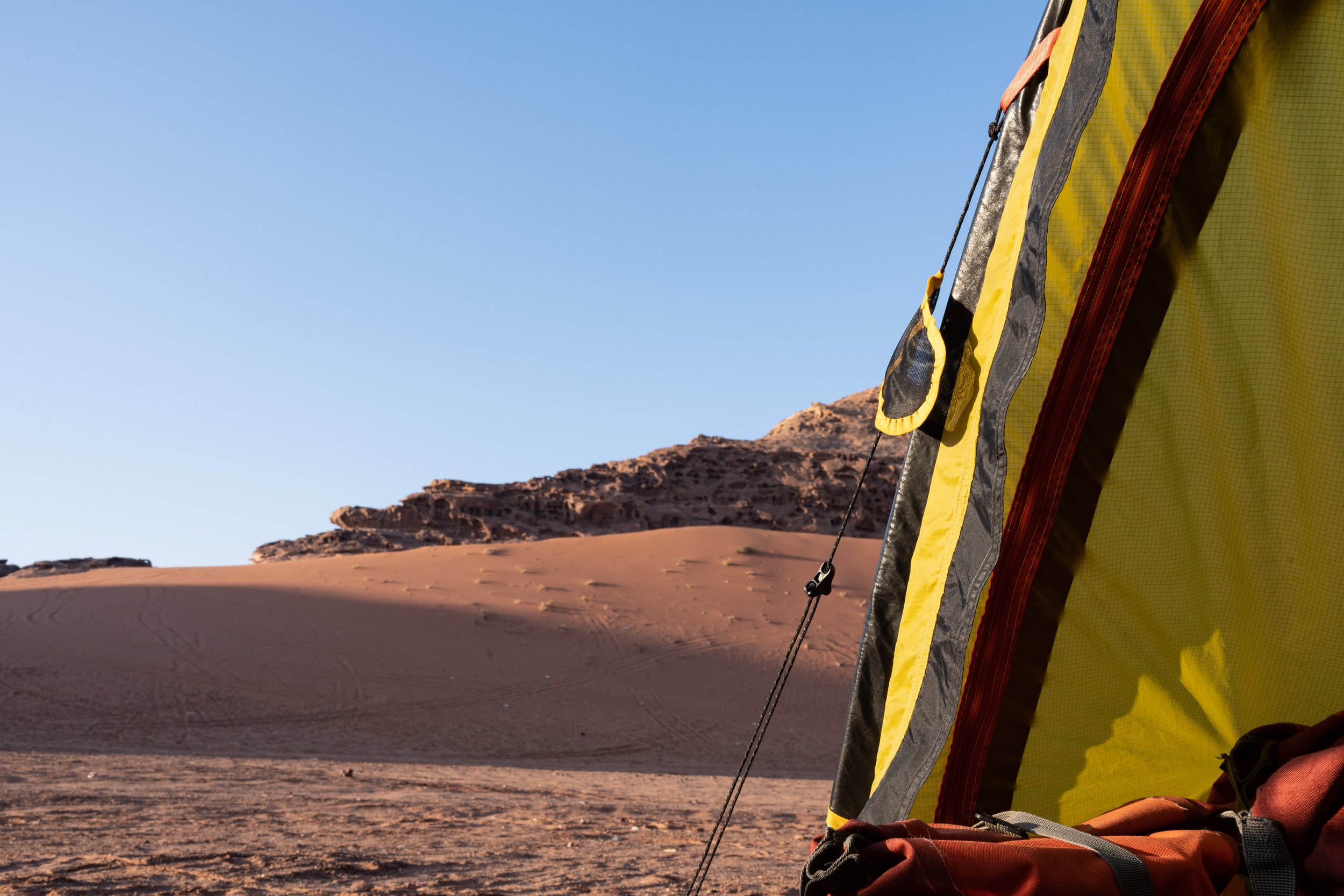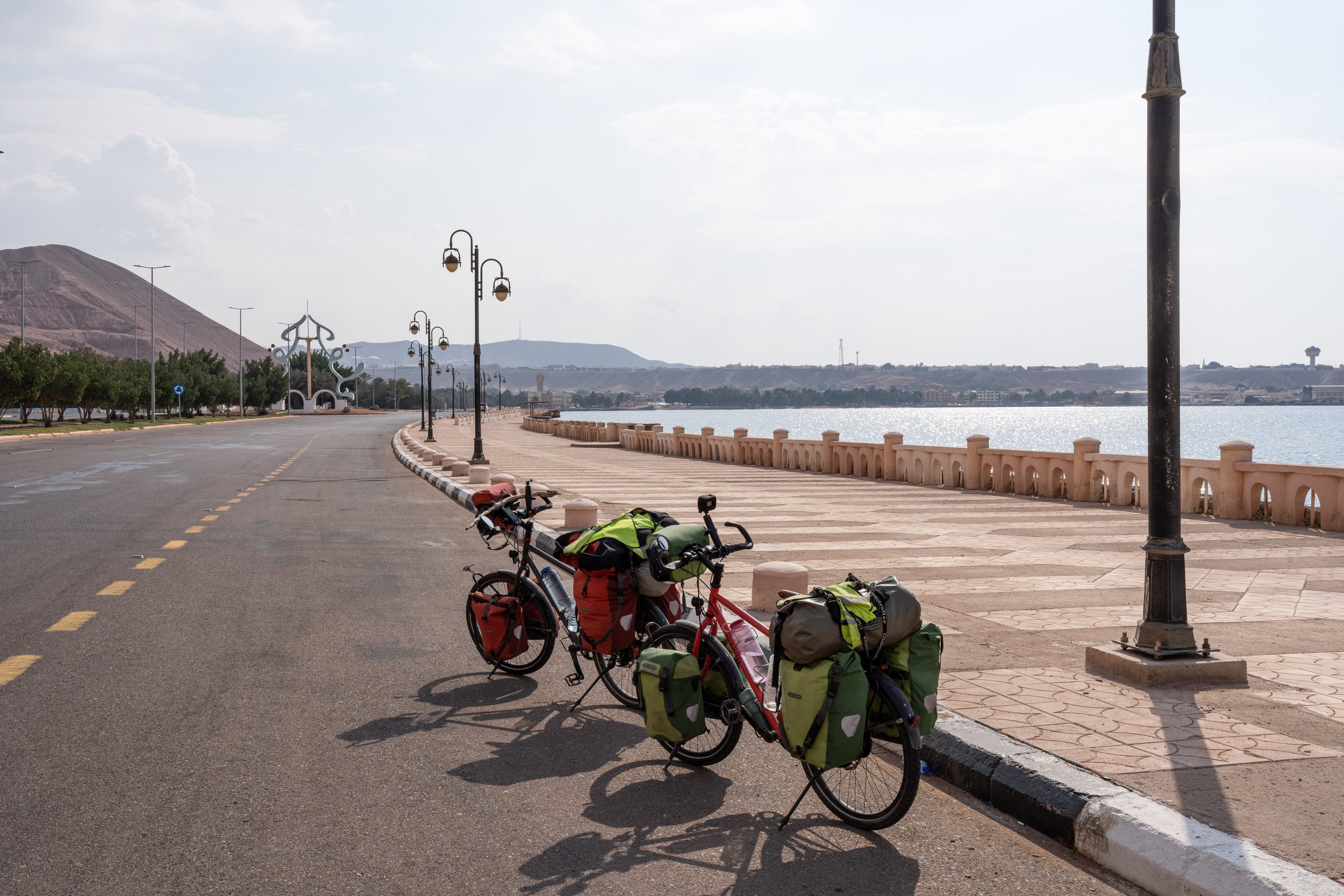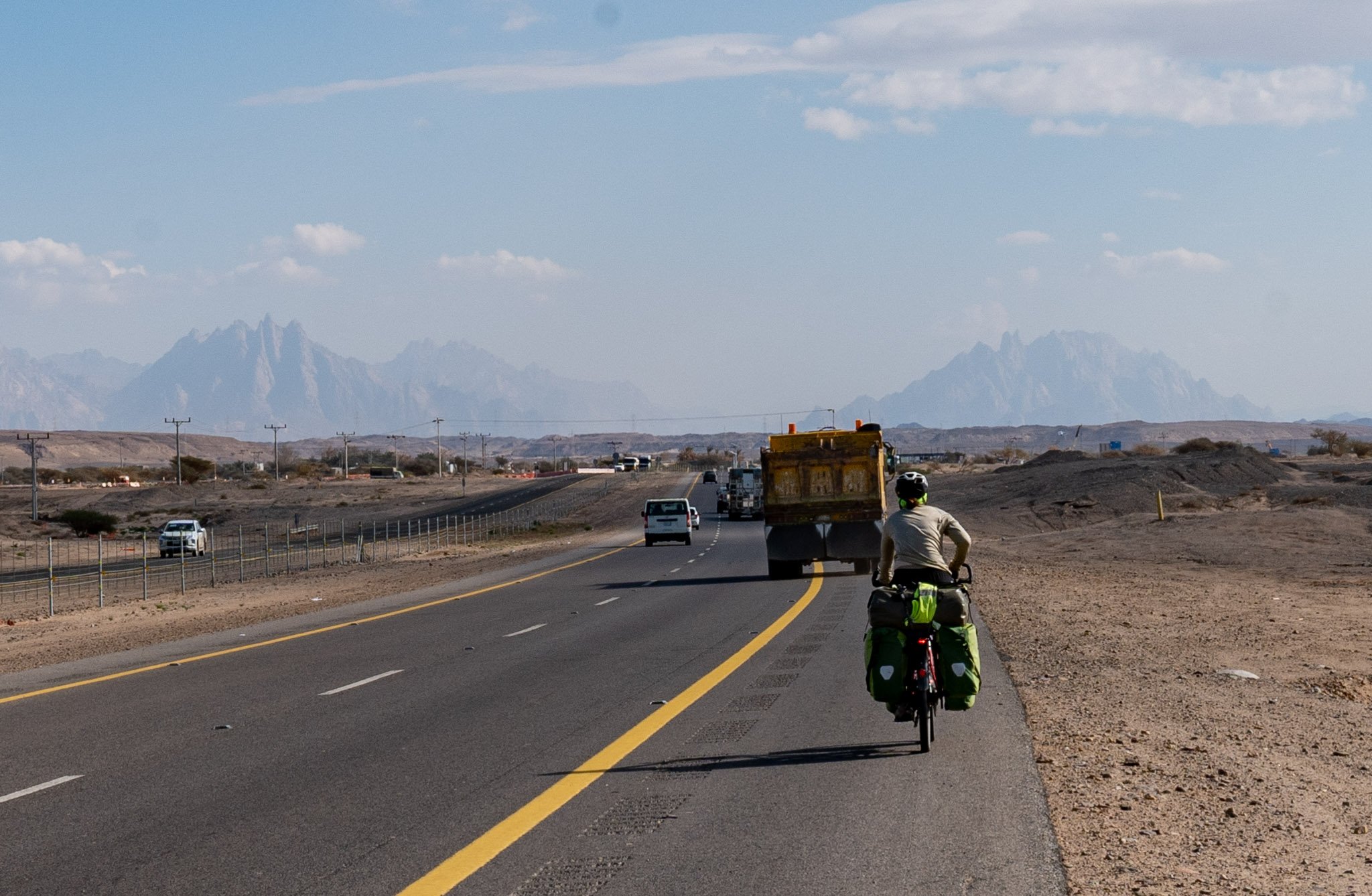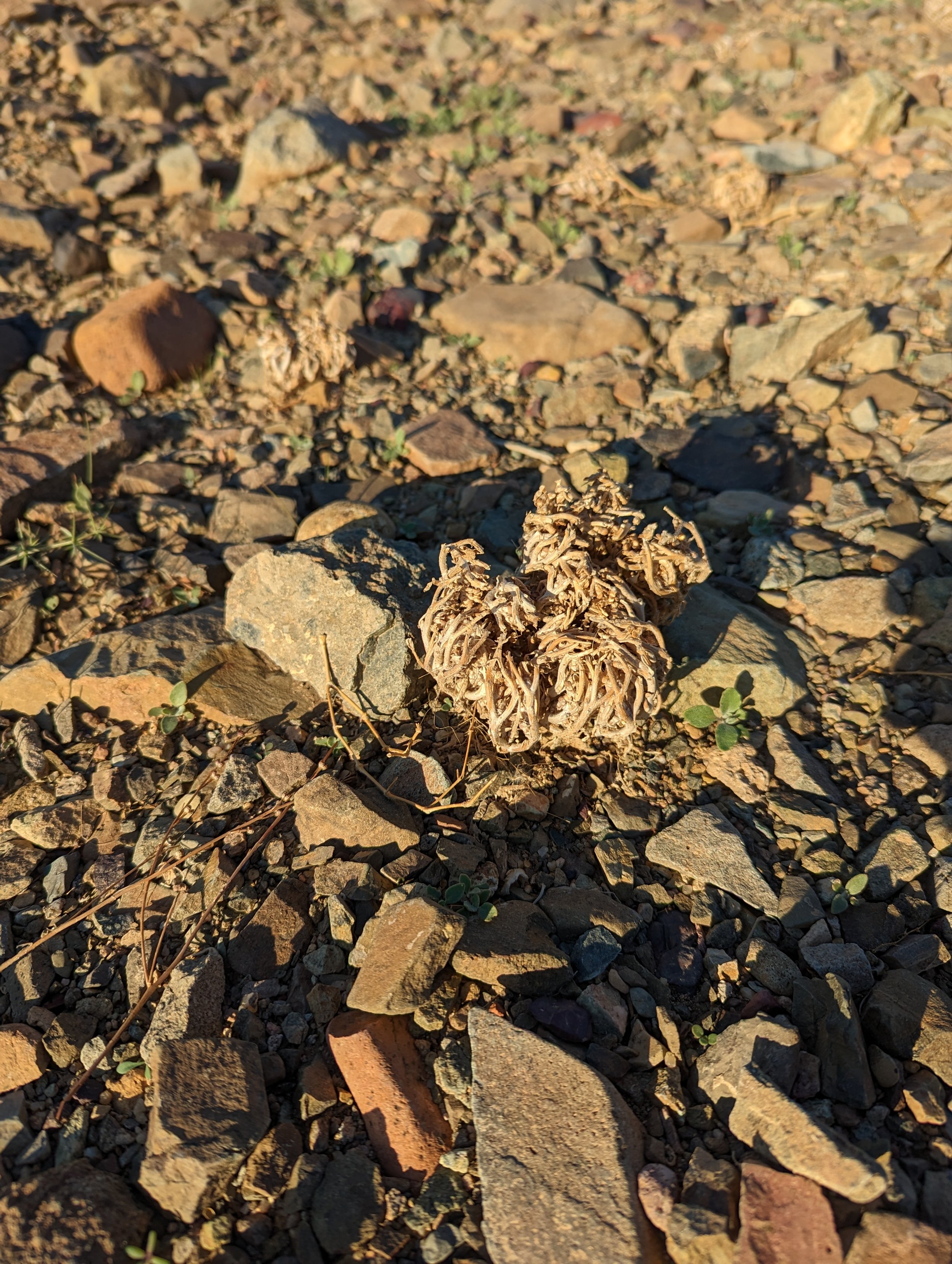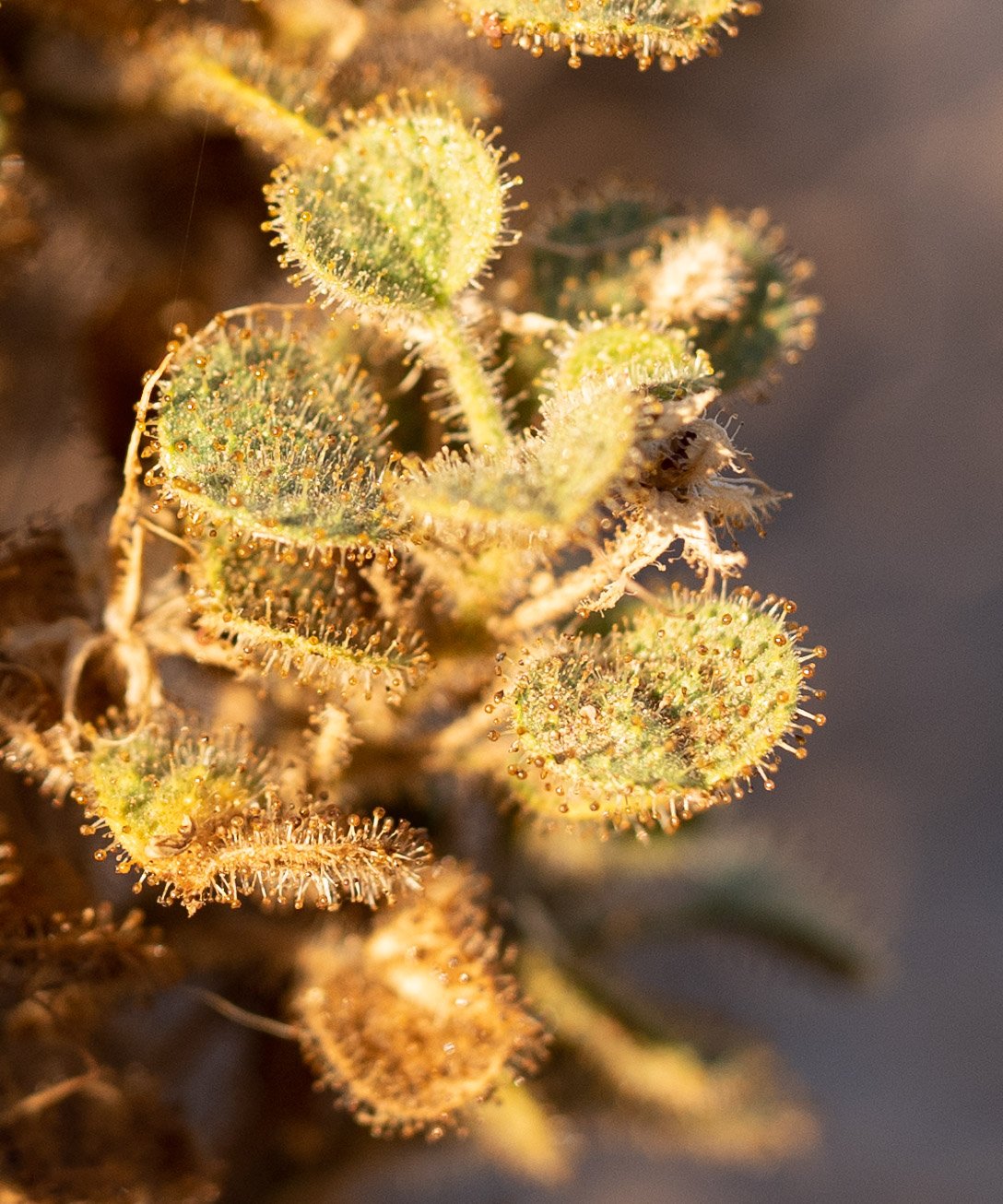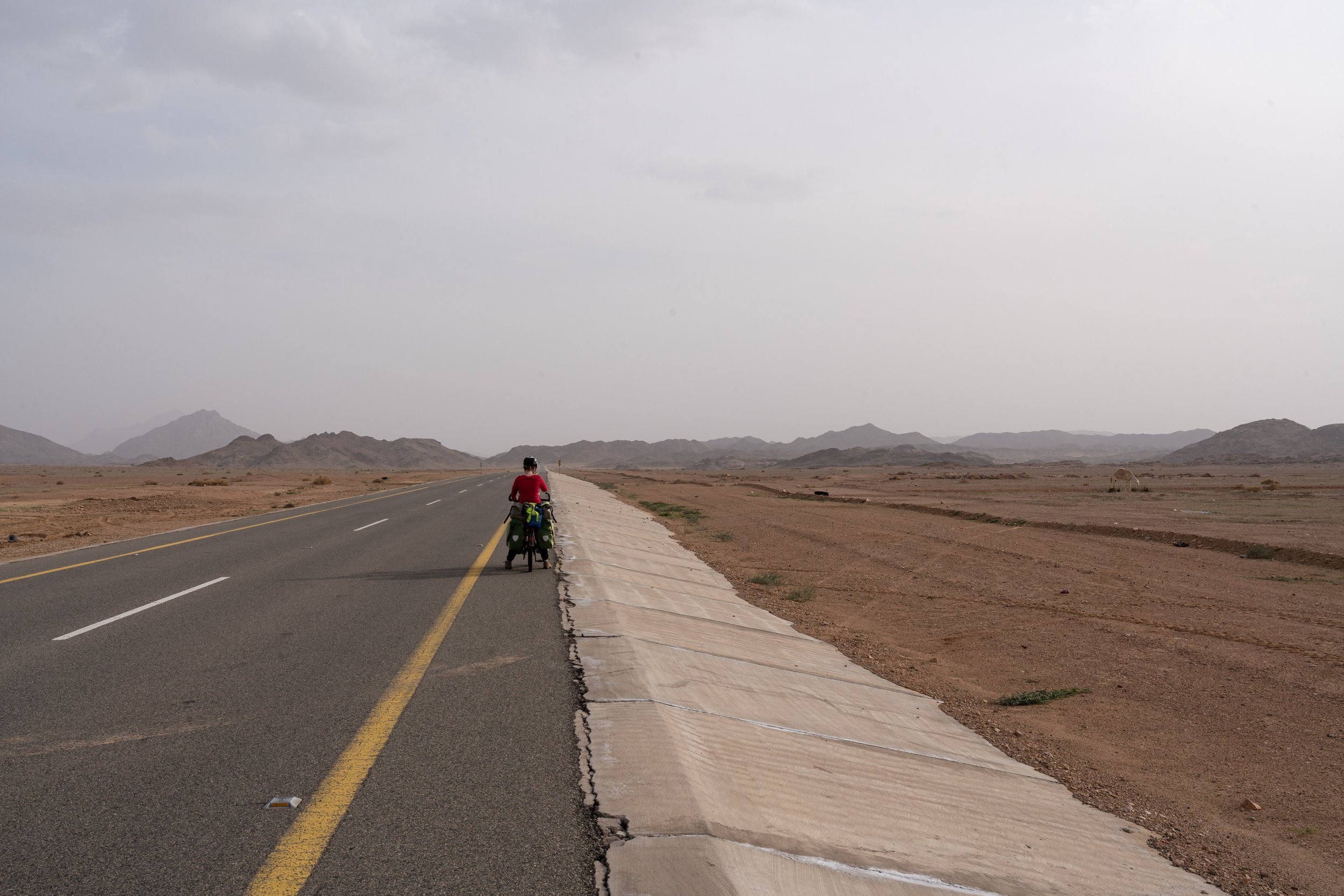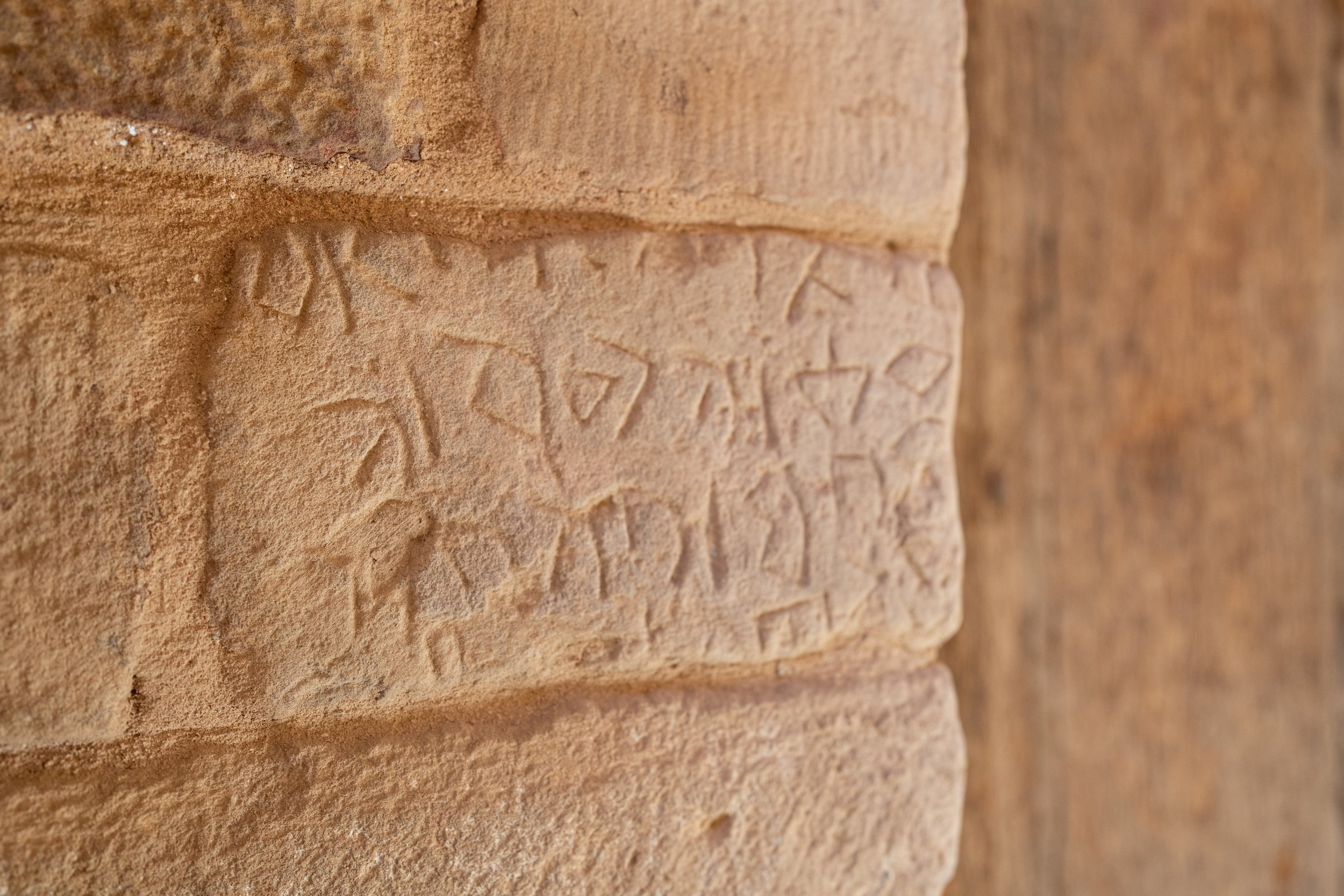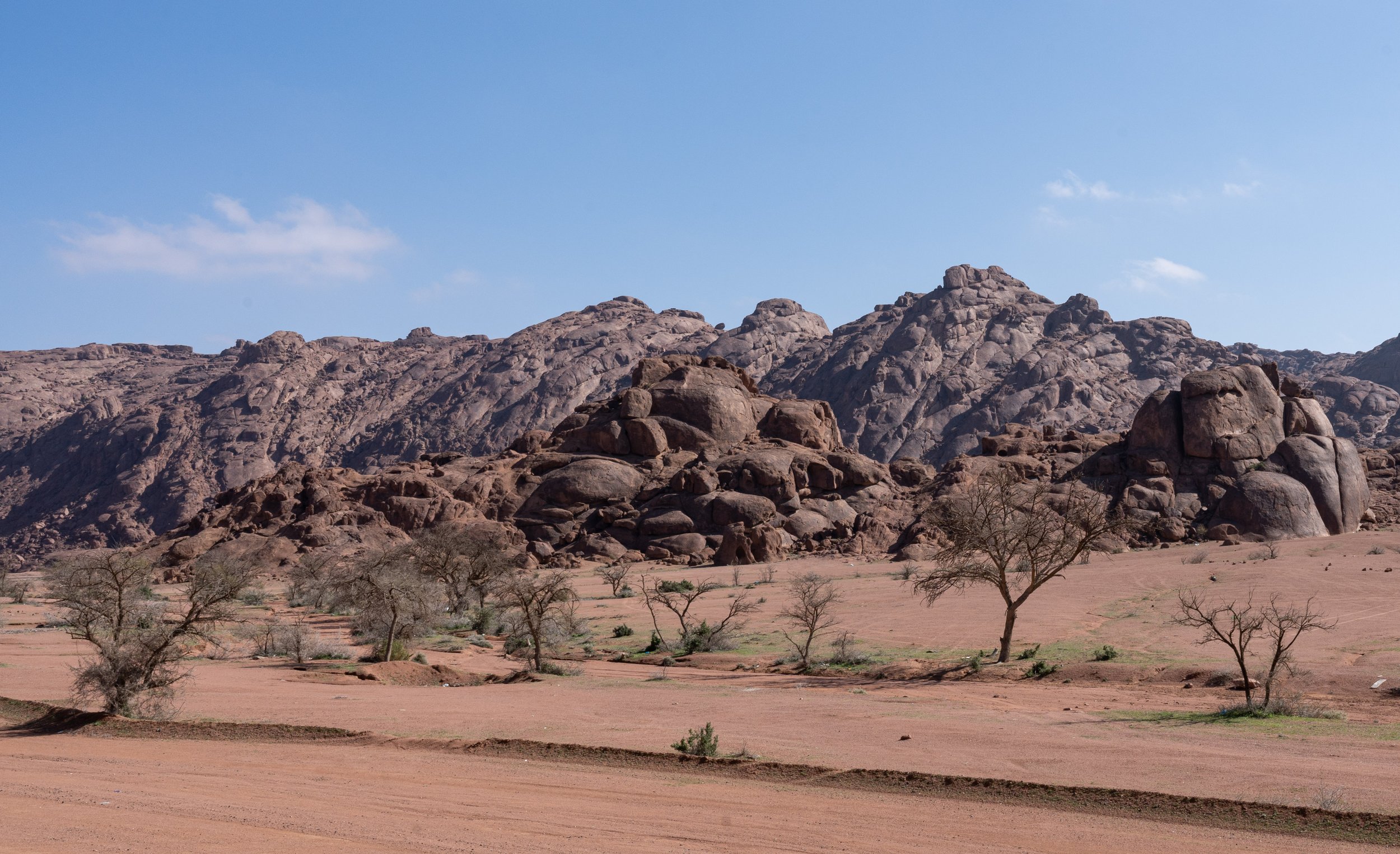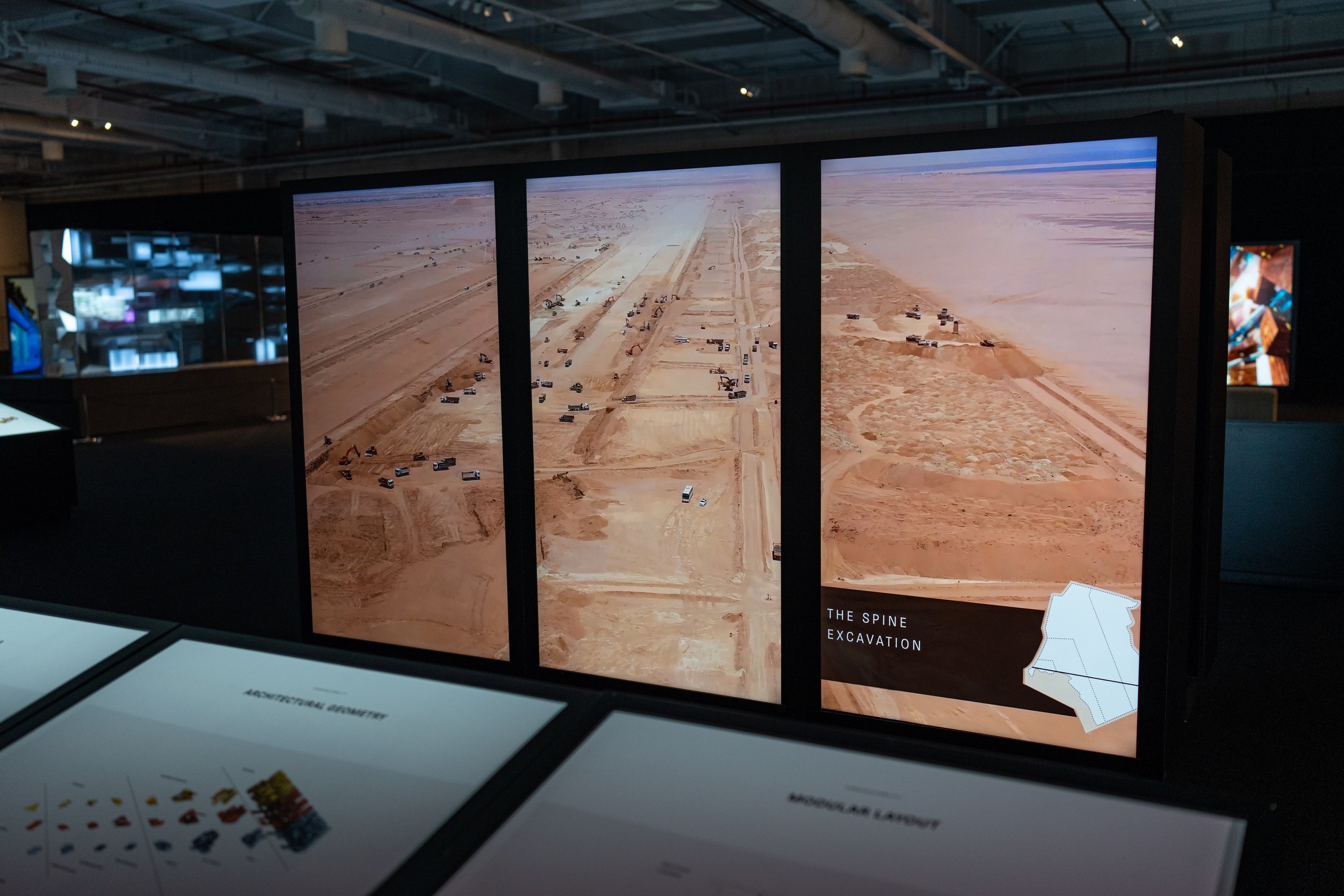From Petra to Riyadh - where science fiction is the neighbor of traditions
It started rather bumpy...
Our plan was actually to take the most direct route to Saudi Arabia from Petra via Ma'an. However, since the security situation in Ma'an was not the best due to violent protests and we had had rather modest experiences with the villagers of this region in southern Jordan, we cycled back to Aqaba. From there it was only a short distance to the Red Sea border crossing. After cycling through a larger industrial area, which seemed rather deserted on a Friday (the day off here), we reached the small barracks at the border fence. The clearance on the Jordanian side was quick, and so we were able to cycle the first few meters on Saudi soil. The border post on the other side was much more modern. And we were greeted very friendly. After checking our passports and visas, the fingerprints were registered. The customs officers following behind the border police were very interested in our previous route and visibly enthusiastic. So here we were. Admittedly, just a few months ago we would never have thought of crossing Saudi Arabia by bike. Luckily we can draw on the experiences of the two German cyclists Jule and Uwe, who showed two years ago that it is definitely possible (www.nurnoch5km.de). The first kilometers in Saudi Arabia led us along the sea coast to the small town of Haql. The place was pretty deserted on a Friday lunchtime, but luckily an Indian man had opened his restaurant. We had to wait until the afternoon to buy a SIM card. When buying a SIM card, the fingerprints must be compared here. Unfortunately, our entries didn't seem to exist in the database, which is why we cycled back to the border police. After confirming that all entries were correct, it was back to the phone shop. Dark now, we left the bikes next to the shop. Unfortunately, at this moment of great inattention, Sonja's GoPro camera was stolen from the handlebar mount. Oh my, what a start... The phone shop clerk and two passers-by immediately helped us to contact the police. They immediately approached with four vehicles and seemed determined not to let it rest like that. Some passers-by had apparently also made observations and came to the police on their own initiative to describe their observations. That was positive: no one left us out in the rain here. After submitting the report to the police station, we looked for a place to stay, meanwhile deep in the night, and went to sleep to recover from the shock. Could we? Nope, an army of mosquitoes had other plans. Heated fighting was fought half the night, with casualties on both sides. We didn't get the easiest start in Saudi Arabia. But what's it called? “If the dress rehearsal goes wrong, does the performance go all the better?” Let's see... The next day we set out for the hinterland. Soon we passed - in the middle of the lonely mountain landscape - the place-name sign of the planned mega-city Neom. Why here in the middle of the wilderness? Well, Neom's concept is to concentrate the population in huge structures like “The Line” (a skyscraper 170 km / 106 miles long and 500 m / 1.640 ft high) in order to conserve over 95% of Neom's area for nature. The establishment of several wildlife sanctuaries is already a testament to this approach. Drivers of passing cars gave us a very warm welcome here in Saudi Arabia. You can sense her sincere happiness that people are finally coming to explore their country from abroad (Saudi Arabia was closed to non-religious tourism until 2019). One of these people was also Abdullah from Duba, a city on the Red Sea, which we would soon reach. He immediately invited us to his home as soon as we would reach Duba - an offer which we gladly accepted. We then spent Christmas Eve in the middle of the mountains southeast of Haql with tangerines and date cake. The winter here brought us pleasant temperatures, but unfortunately also one or the other storm. Fortunately, a thunderstorm just passed us that night, because we were quite exposed in the steppe...
Where science fiction should become reality...
On our way south, we soon crossed the place where “The Line” is supposed to be, a futuristic city, which will be completely different from all previous cities of mankind. And when we get there, we quickly realize that they are serious. In addition to “The Line”, Neom is to have a floating harbor and a huge solar power plant, among other things. Earthworks are now taking place all over the site (it takes more than a day to cycle through it). Where three excavators might be working on a European construction site, dozens are digging next to each other here. The excavations are transported by hundreds of trucks. It may be that this project is not (yet) taken very seriously in the west, but we will go into more detail later on why we hope Neom can be realized as far as possible and why we wish the endeavor every success. After a few days we finally arrived in Duba, where we were warmly welcomed by Abdullah and his sons at his home. Saudi hospitality is huge. If one is invited, there is very often the dish “Kabsa” (chicken on rice) to eat. Eating is done with the hands or a spoon on a carpet on which the food is spread out. We were invited by Abdullah to take a break at his place and stay here for a day. In the afternoon he showed us Duba: a pretty town with a large park by the sea. The next morning we received a call from a cheerful inspector from Haql: the theft of the camera had been cleared up and the GoPro was ready to be picked up! We are impressed - in the vast majority of countries the complaint would certainly have simply been filed away in such a case... And again Abdullah helps us enormously by driving us the almost 300 km (186 miles) back to Haql to pick up the camera from the infirmary. Thank you very much for your hospitality and helpfulness, Abdullah! We very much hope to be able to welcome you to our home in Germany! We left the Red Sea coast and cycled from Duba to the Hijaz Mountains. The landscape tends to be barren, but right now grass has grown out of the ground next to the large puddles in many places as a result of the rain. The camels were happy - more water than they can drink and more greens than they can eat. The drivers of the passing cars continued to greet us warmly. And we were often given water, snacks, sweets or even two corn cobs. On the way to the oasis Wadi Disah we were invited to a Saudi coffee for the first time. This type of coffee is made from only lightly roasted coffee beans with plenty of green cardamom, is light in color and tastes completely different from the coffee we are familiar with. Highly recommended! At the eastern end of the Hijaz Mountains we reached the oasis of Al Ula. The place is currently being developed into a tourist attraction. In the north near Hegra are the rock tombs of a lost city of the Nabataeans, the builders of Petra. In Al Ula itself, the ruins of the old town built in adobe can be visited. This type of construction was typical for the entire Arabian peninsula until about a hundred years ago. From Al Ula we cycled hundreds of kilometers through an open steppe landscape to Hail. The distances here are enormous. Even if the world maps do not necessarily suggest it due to their two-dimensional projection: the Arabian Peninsula is the largest peninsula on earth. Often 100 kilometers (62 miles) to the nearest gas station, with nothing in between. Headwinds can be torturous here, but apart from two minor storms (for which we found shelter for each), the weather was kind to us. But in Hail we took a short break before continuing.
Through sand dunes to the origin of the Kingdom
To save some miles, we followed the highway southeast from Hail. That meant driving straight for two days without a single small turn. Left and right the view across a flat surface to the horizon. An exciting experience - cycling becomes almost meditative (provided there is no headwind). Soon we reached Buraidah, the city with the world's largest date market and the world's largest camel market. Outside of certain festivals, the date market is rather manageable, but of course we still got dates from the region. From the Al-Qasim region around Buraidah we were now accompanied by a police escort to the outskirts of Riyadh. This is the case for the vast majority of cyclists in Saudi Arabia, but it is always well intentioned (more on this in the last paragraph). South of Buraidah, an almost completely empty road led us through an impressive dune landscape - clearly a highlight so far! West of Riyadh we then left the road for an afternoon and followed a reasonably ridable sand and gravel road to the “Edge of the World”, a massive cliff edge of the terrain above the lowlands. The scenery is impressive! Since staying overnight is strictly forbidden here, the police escort took us back to the street in the evening, where we were then able to pitch our tent. We reached the outskirts of Riyadh through the Wadi Hanifa. This valley, which currently also carried water, is the origin of the Saudi Kingdom. Here Diriyah was the capital of the First Kingdom. The Ottomans destroyed the city in 1818 after a long siege, but the ruins of the former palaces - built in the traditional mud construction of the central Najd region - can be visited today. Not far from the ruins of the old town is the exhibition “The Line Experience”. We can only warmly recommend visiting this exhibition, because here the abstract idea of “The Line” gets a face. Elaborate miniature models show what the interior of "The Line" might look like: hanging gardens and forests, open viewing platforms, small lakes and open swimming pools. As indicated above, the basic concept is to concentrate as many residents as possible in a small space in what is actually quite a hostile environment in a building that has its own beneficial microclimate. Good air quality and light flooding should be made possible by the design of the interior of “The Line”. The concept relies on short horizontal and vertical routes, which is why "The Line" should enable a completely car-free life. It is actually not surprising that such a project should be realized here of all places: Riyadh itself is currently a 100% car city. There are usually not even pedestrian traffic lights. Even walking 100 meters (328 ft) to a shop across the street can be a challenge when there is a busy, multi-lane road in between. Projects are now also being launched in Riyadh to give pedestrians and cyclists space. Today's Riyadh in particular shows why the quality of life in a pure car city quickly reaches its limits. All the more logical that with the income from oil exports, a project is to be implemented with Neom, which represents an exact counter-proposal to a Car City. How Neom and “The Line” will actually look like remains to be seen. We personally hope that the implementation will be as successful as possible and that Neom can one day become a technological inspiration for the development of other districts.
About cycling on this section
One important piece of news first, as there is still some outdated and incorrect information circulating on the internet: Yes, women are allowed to ride bicycles in Saudi Arabia. We didn't see a single local woman on a bicycle, but legally there's nothing standing in the way. Nobody was openly bothered (especially not the police) that Sonja was sitting on a bicycle. No one protested or bothered us about it. On the contrary: most of the people we met were even enthusiastic about it!
From Petra to the southern border of Jordan: From Petra we followed the Kings Highway (No. 35) back to the Desert Highway (No. 15/47). The road is quite hilly, but has pleasantly little traffic and is mostly in good condition. More importantly, the people here are used to foreign visitors, which is why, unlike in the region to the east, no stones were thrown in our direction. We then cycled back to Aqaba on the already known route and from there to the Durra/Haql border crossing. Other bike tourists have found that they were not allowed to cycle all the way to the border on the Jordanian side, but had to load their bikes onto buses or trucks. We were cycling on a Friday (i.e. the non-working weekday here) on the empty road through the industrial area (No. 47, west near the coast) and were allowed to cycle through there to the border crossing. In the end it probably always depends on the decisions of the police officers on duty whether you are allowed to cycle to the border or not. Attention: When leaving Jordan, an exit fee of 10 dinars per person (December 2022) is due, which must be paid in cash - if you drive to the border, this amount should still be in your wallet, as there are no ATMs available at the border crossing stands!
In Saudi Arabia - the roads: From Haql in the far northwest we followed road 55 via Neom and Sharma to Duba on the Red Sea. (Attention: the smaller road, which runs directly along the sea coast from Haql to the south, is apparently permanently closed.) Road no. 55 is in very good condition and mostly has a shoulder on which you can cycle. An exception currently (December 2022) exists on a section between Al Muwaileh and Duba: as a result of the earthworks for part of the Neom project, there is a kind of "roundabout" of countless trucks loading in one direction with excavated earth and then back in drive the other direction unloaded. This section is a few kilometers long and not without danger, as a continuous queue of hundreds of trucks rumbles past you (as a European, you can't even imagine this dimension). There is (mostly) a hard shoulder on this section to the south, but not to the north! We are therefore glad that we were not traveling in the opposite direction here. From Duba we followed roads 80, 8756 and 8761 to Wadi Disah. We can recommend this route without reservation: the traffic is light, the roads are always good. The same applies to the unnumbered road between Shaghab and Bada and the No. 8776 to Al Ula. From Al Ula we cycled on the also very good and rather quiet No. 70 to Hail. From there we wanted to shorten something and took highway no. 65 to Buraidah. It has a wide hard shoulder throughout and actually surprisingly little traffic, but it is completely fenced off so that camels and sheep cannot get onto the road. Finding a place to camp or take a break can be made more difficult by the fencing. From Buraidah we took smaller roads to Riyadh again: first the no. 413 to Al Mithnab, then the 5909 (great: lonely through the sand dunes!) to the no. 505 and from Shaqra the no. 546. Just before Riyadh we changed to the smaller No. 5762 and then followed No. 5767 through Wadi Hanifa to the western outskirts. Cycling in Riyadh itself is not a particularly pleasant affair. It is important to plan the route through the city in detail in advance, so as not to end up with unnecessary dead ends on the side streets (this happened to us twice anyway). However, we have had a good experience with “Wadi-Hanifah-Street” in the western part of the city: it is not only comparatively quiet, but also leads through an amazingly beautiful part of the city.
Ah, and one more detail about road traffic that is perhaps not trivial: children from the age of 10 and up can drive a car here. That's no joke. At first we thought they were trying to prank us, but no, that definitely happens here. So you shouldn't be surprised if a fourth grader suddenly climbs out of his full-size SUV, that's quite normal... Sometimes you think a car is coming towards you without a driver, but then you discover the nipper behind the wheel. Well, different countries, different customs.
In Saudi Arabia - the shopping possibilities on the way: Due to the enormous distances, crossing Saudi Arabia requires a certain minimum of planning regarding the shopping possibilities. On our route, there were often 60 - 80 kilometers (37 - 50 miles) between two gas stations with small shops, but sometimes up to 140 kilometers (87 miles). Depending on the route, these distances can be even greater. Some gas stations and shops listed in Google Maps are now closed - so we made sure that there were more recent Google reviews when planning. In general, there is hardly any infrastructure in the form of overnight accommodation or restaurants outside of the larger cities and touristy places - we would therefore recommend that even travelers who want to travel by car in Saudi Arabia take a tent and a stove with them. Good news: the Saudis themselves love to go out into the wilderness for picnics, which is why camping equipment can be bought in many places. Gas cartridges with screw thread and plug-in cartridges are available at almost every gas station. One more thing to plan for: while winter here offers comfortable temperatures for cycling and comparatively little sunshine, it also brings with it a certain risk of thunderstorms and sudden flooding. The weather forecasts and any weather warnings should therefore be checked carefully before the long stretches of desert! Good: in the event of acute severe weather warnings, you get an SMS from the Saudi civil defense directly on your cell phone.
In Saudi Arabia - the police escorts: In our opinion, this topic is currently preventing some cyclists from traveling to Saudi Arabia. Pretty much all cyclists "get caught" here at some point: suddenly a regular police vehicle or a civilian vehicle always drives close behind you or keeps a certain distance, but always stays close. Even when camping, a vehicle remains nearby for observation. First of all: they actually always mean well, and sincerely. It can happen that higher authorities order an escort when cycle tourists move around in their area. That's the way it is, there's not much you can do about it. There also seem to be regional differences: While we were completely unescorted in the north-west of the country, we were always accompanied from the province of Al-Qasim to Riyadh. The police officers were always very helpful and friendly towards us. Once we were recommended a good place to camp, another time the policeman accompanying us bargained the price down for us in a hotel, and once again we were given a bag of food to take with us in the evening. Or they backed us up on really tricky, congested sections. Thank you for this support! We've also spoken to locals about this: while they also realize that these escorts aren't really necessary, this kind of extra protection should be seen more as a form of special hospitality. As one put it: "Feel like celebrities who always have a bodyguard with them." We don't think police escorts are necessary either, but we also don't think that it should put you off if you're exploring Saudi Arabia by bike.

